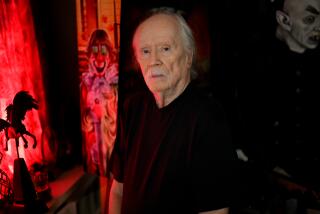Pocketful of Memories
- Share via
Jimmy Stewart probably said it best: “Frank Capra made you pay for those happy endings.”
No other director in American film put his protagonists through such grueling rites of passage only to have them survive on top a little wiser and more resilient--and possessing more friends than they ever imagined.
And like his heroic protagonists, Capra experienced his own grueling rite of passage. His life could essentially be summed up as a series of personal and professional triumphs interspersed with nagging self-doubt and bitter disappointment. But through it all, his idealism remained intact.
At least according to “Frank Capra’s American Dream,” the documentary premiering Friday through Sunday as part of the Nuart’s two-week Capra centennial retrospective, which finally puts to rest the shallow “Capracorn” epithet.
“His was an ambiguous life,” asserts film historian Richard Schickel at the outset, a pivotal theme the documentary (written and directed by Kenneth Bowser) emphasizes throughout its narrative, commentaries and abundant film clips.
Capra’s dark side still comes as a surprise to many observers, proof of how misunderstood he continues to be. But name another director whose films are so preoccupied with suicide.
Tom Capra, the director’s youngest son--who executive-produced “American Dream” with brother Frank--even finds it amusing. “Yeah, look carefully at the movies,” the former TV news producer says.
Originally conceived as an hour TV special with Columbia-TriStar, “American Dream” was rejected by the networks but then co-financed by American Movie Classics, which will show the documentary on Sept. 23 as part of its own Capra tribute.
“So many people wanted to be in it that it wound up being feature-length,” Capra says. “The only one we couldn’t get was [Steven] Spielberg, who really wanted to be in it, but was just too busy making two movies.”
Capra did get Martin Scorsese, Richard Dreyfuss, Michael Keaton and Marshall Herskovitz (whose production company is named Bedford Falls), among others, as well as a few unexpected participants.
“We interviewed Robert Altman because he is sort of anti-capitalist,” Capra says. “John Milius came through so well because he’s always speaking from a historical perspective. I asked Oliver Stone to specifically talk about the war experience and how that affects a person and how you can come back from it--and how hard it is to make movies that criticize the system.”
For narrator, Capra says Clint Eastwood, Kevin Costner and Tom Cruise expressed interest, but that Ron Howard was the most insistent. “He would not be denied. He was going to narrate it. Period.”
It’s not surprising. Given the phenomenal popularity of “It’s a Wonderful Life,” Capra is the comedy and drama role model for the current generation of directors. He not only was the master of character development but also of cleverly shifting moods in a scene.
In addition, Capra assembled one of the most memorable acting troupes in film. “All the actors--especially the bit actors-just loved him. He used to give each one of them a role. He would go around the set and say, ‘Your mother’s sick, can you hurry for the bus?’ ‘You just had a fight with your wife and you’re drunk.’ Ward Bond--who was in everyone’s movies--was a cop three times and a bus driver once.”
Like all directors of his generation, Capra didn’t aspire to make films. The poor yet brash Sicilian immigrant had a talent for hustling, which served him well growing up on the streets of L.A. after the turn of the century. He studied engineering at Caltech, but gravitated to filmmaking in San Francisco after World War I, learning the mechanics of film by editing rushes (“Greed,” of all things).
“Scorsese talks in the documentary about how Dad was not only learning his craft but perfecting it at the same time,” Capra says.
And part of the process was learning how to thrive on adversity and tension; witness Capra’s emotional breakdowns after the failure of “The Bitter Tea of General Yen” (his only art film) and the success of “It Happened One Night” (his breakthrough Oscar winner)--as well as his volatile relationships with Columbia mogul Harry Cohn (one of Hollywood’s best hustlers) and screenwriter Robert Riskin (whose ideology was much more liberal).
The director’s longest and most artistic collaboration, however, was with cameraman Joseph Walker, who defined the Capra look with shadow and contrast.
“All my favorite shots are in the documentary. The shot of Jean Harlow [in “Platinum Blonde”] gettin’ [kissed] through the water. And he used multiple cameras so effectively. You can see it in those crowd scenes. The run on the bank [in “American Madness”] . . . that shot with all those hats coming through the door is incredible.
“That shot [in “It’s a Wonderful Life”] where Jimmy finds out that his brother’s got a job. The camera just follows him around. It’s all in his face. His whole life passes before him and he knows he’s never gettin’ out of Bedford Falls.”
With the recent passing of Stewart, Capra mourns not only one of his family’s dearest friends but also his father’s favorite actor, whose persona he shaped by utilizing an untapped darkness.
“Jimmy told this incredible story at Dad’s memorial service at the Directors Guild. After the [Second World] War, Jimmy came back and never thought he was gonna get a job again. And Dad called him about a new movie he was making, which, of course, was ‘It’s a Wonderful Life.’
“So Jimmy went on and on about their meeting where Dad talked about a suicide and an angel. And he said all he could think about was, ‘Gee, I hope he offers me the job.’ When Jimmy got to the point, he said, ‘I didn’t care about angels. I wanted the job. I got the job.’ ”
With “It’s a Wonderful Life,” both star and director reached the apotheosis of their careers, exploding the American dream with hallucinatory horrors about the country’s postwar fears and anxieties. But it was not what the country wanted to see at the time.
“It was so good for Dad that the film caught on years later. We’d have dinner on Christmas Eve and then we’d watch ‘It’s a Wonderful Life’ and then we’d go to midnight mass.”
Capra, who also fondly remembers fly-fishing and hiking as a child with his father near their summer home at Mammoth, hopes “American Dream” and the centennial exposure will help inspire a younger generation to discover the entire range of his father’s films (with assistance from Columbia-TriStar’s recent home video package that includes the documentary and the premieres of “Miracle Woman” and “American Madness”).
“The thing about the documentary is that we show how Dad’s films mirrored America during the ‘30s and ‘40s.”
Or, as another unlikely Capra admirer, John Cassavetes, once said: “Maybe there really wasn’t an America, maybe it was only Frank Capra.’ ”
BE THERE
“Frank Capra’s American Dream,” the Nuart, 11272 Santa Monica Blvd., (310) 478-6379. Admission is $4.75 for senior citizens and children under 12; $8 for all others.
* MORE CAPRA
The director’s life and work are saluted at Nuart. Page 12.
More to Read
Only good movies
Get the Indie Focus newsletter, Mark Olsen's weekly guide to the world of cinema.
You may occasionally receive promotional content from the Los Angeles Times.









